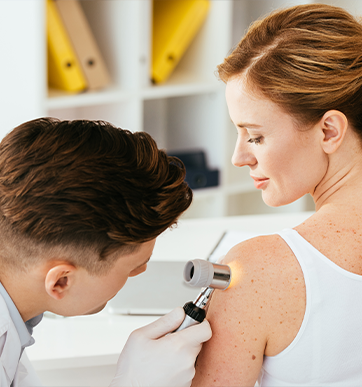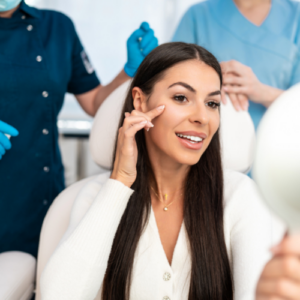
Skin Cancer Awareness Q&A
May is here and summer is just around the corner. The weather is getting warmer, sunny skies are on the horizon and you’re probably itching to whip out those sundresses, short shorts, and tank tops to soak up some much needed sunlight. Take pause before you go rushing out the door. May is also Skin Cancer Awareness Month and Dr. Peter Webb is here to address some frequently asked questions as well as common misconceptions when it comes to skin cancer.
As you probably know, skin cancer is primarily caused by UV Rays, but did you know that as many as 1 in 5 people will have skin cancer in their lifetime? Let’s explore a few other things you should be aware of.
Q: What are the different types of skin cancer to be aware of?
Dr. Peter Webb: There are three main types of skin cancer. Basal Cell, which is the most common, Squamous Cell carcinoma and, Melanoma, which is less common but also the most dangerous and potentially lethal.
Q: What steps can be taken to prevent skin cancer?
Dr. Peter Webb: We over rely on sunscreen when the best way to prevent skin cancer is by covering up with clothing or sun hats when going outdoors. Often, you’ll see people apply sunscreen and they still get sunburn or they’ll go on vacation and come back with some color. Ideally people should do both, wear sunscreen and cover their skin when they are going to be outdoors or exposed to the sun for long periods of time.
Some people will be concerned that this prevents them from getting a sufficient amount of Vitamin D, but there are gel tablets and other options to take Vitamin D as a supplement rather than through sun exposure.
Q: How often should an individual get checked for skin cancer?
Dr. Peter Webb: I like to use the reminder to check your birthday suit on your birthday. Adults 45 and up should get skin cancer screenings annually, and patients that have previously had skin cancer may need to come in for check-ups every six months because your risk goes up if you have had skin cancer before. Melanomas are occurring more frequently in younger adults, so it’s important to know your body and what to look for.
Q: How can people perform a self-check and how might they identify a concern?
Dr. Peter Webb: It’s important to perform self-checks and to check everywhere, your face, your scalp, your back. Use a mirror or have a family member help you with your back.
There are a couple ways to self-test for skin cancer. One method called Scrub test – you take a towel and rub your whole face with pressure. If you have bleeding from the scrub test then you need to get checked because bleeding is a warning sign.
Additionally, if you have an irregular pimple that lasts more than a month, it’s important to get checked by a physician or dermatologist.
The Ugly Duckling test is another one. Keep an eye out for a mole, mark or spot that looks really different from the rest of your skin spots.
The American Academy of Dermatology also publishes a method of looking at moles called the ABCDE’s of Melanoma. Based on their guidelines, it’s important to look for:
- Asymmetry – if one half of a mole is unlike the other
- Border – an irregular or poorly defined border
- Color – a mole should primarily be one shade, not multiple colors
- Diameter – moles larger than a pencil eraser (6 millimeters)
- Evolution – be alert for moles that change over time
Q: How is skin cancer treated?
Dr. Peter Webb: One of California Skin Institute’s primary treatments for skin cancer is surgical removal using Mohs surgery. The procedure was named after Dr. Mohs, who invented it, and it allows for the affected area to be treated while minimally impacting the surrounding area.
There are additional options such as radiation for non-surgical treatment, even topical creams may be considered an option in some cases. Melanoma is typically treated surgically.
Q: Who is most susceptible/at high risk of developing skin cancer?
Dr. Peter Webb: People with fair skin, adults 45 and up, people who have previously had skin cancer tend to be at higher risk.
Let’s discuss some common misconceptions about skin cancer.
Q: Is there such a thing as a healthy tan?
Dr. Peter Webb: Pale skin is healthy and youthful skin [for people who naturally have a fair complexion]. There is no such thing as a healthy tan. Some people are using artificial tan, which is fine, but it’s important not to be fooled into thinking that it will protect you from sun damage. It doesn’t work like sunscreen. You still need to wear sunscreen and cover up.
Q: Is skin cancer only a concern for older adults?
Dr. Peter Webb: The incidence of melanoma is actually highest in younger adults, especially ages 30-50.
Q: Can you only get skin cancer in places that are exposed to the sun?
Dr. Peter Webb: It’s true that many people will discover skin cancer on their face, but skin cancer can occur anywhere on the body, like the bottom of the foot, behind the ears or underneath the nails.
One statistic that we’ve seen is that women develop melanoma more frequently on their lower legs than men and this is believed to be related to women wearing dresses or skirts which leave their legs exposed to the sun more frequently.
Q: Is it possible to repair past sun damage?
Dr. Peter Webb: It’s never too late to start taking steps to protect your skin. Your skin is constantly renewing itself and will start benefiting soon after you start taking precautionary steps to protect it.
 Dr. Peter Webb is a board-certified dermatologist who works out of our Daly City and San Mateo offices. He specializes in medical and cosmetic dermatology. He received his PhD in Biochemistry from Princeton University, and attended the University of Miami for medical school. Dr. Webb completed a medical internship at UCLA and underwent three years of dermatology training at UCSF. He is a member of the American Academy of Dermatology and the American Society for Dermatological Surgeons.
Dr. Peter Webb is a board-certified dermatologist who works out of our Daly City and San Mateo offices. He specializes in medical and cosmetic dermatology. He received his PhD in Biochemistry from Princeton University, and attended the University of Miami for medical school. Dr. Webb completed a medical internship at UCLA and underwent three years of dermatology training at UCSF. He is a member of the American Academy of Dermatology and the American Society for Dermatological Surgeons.



 / 291 Reviews
/ 291 Reviews